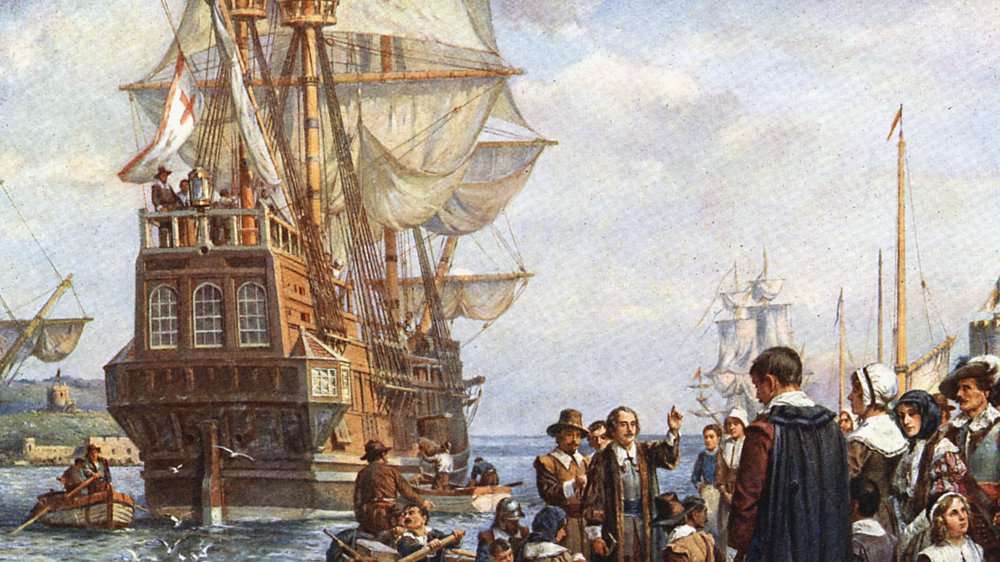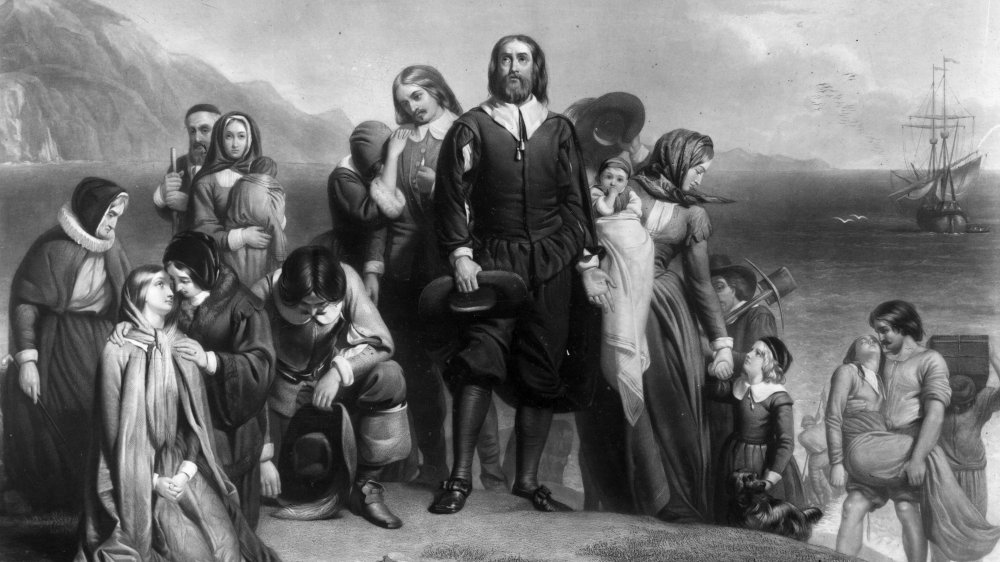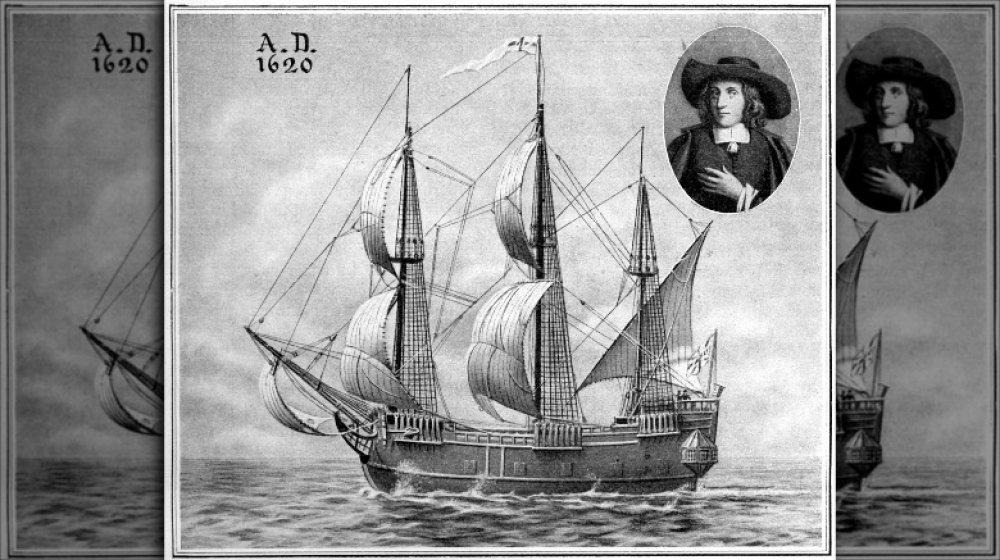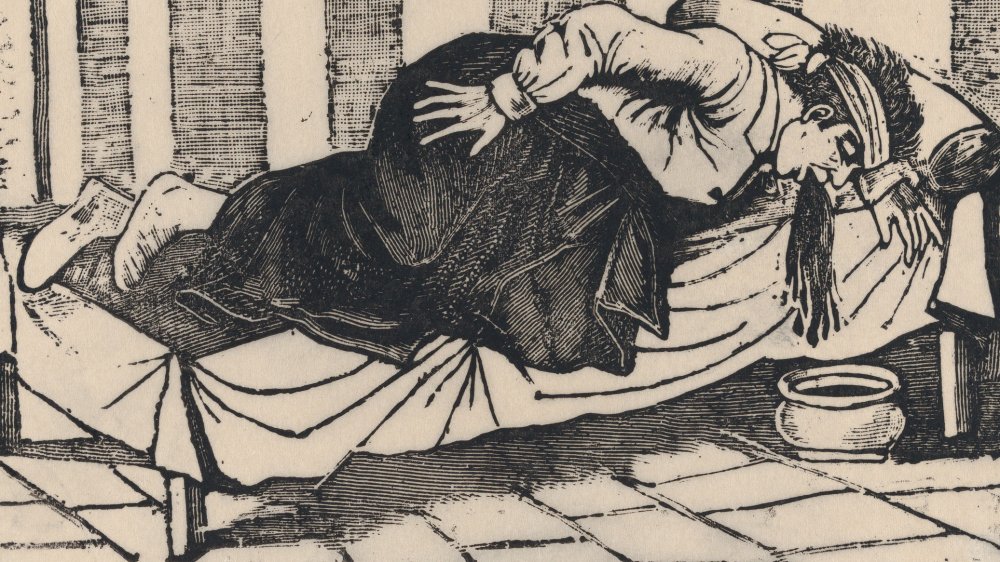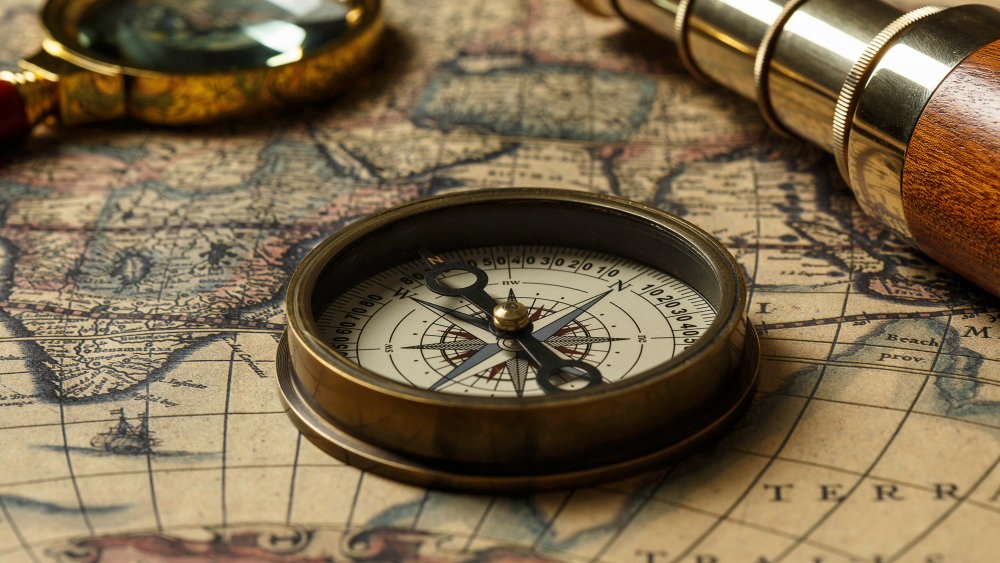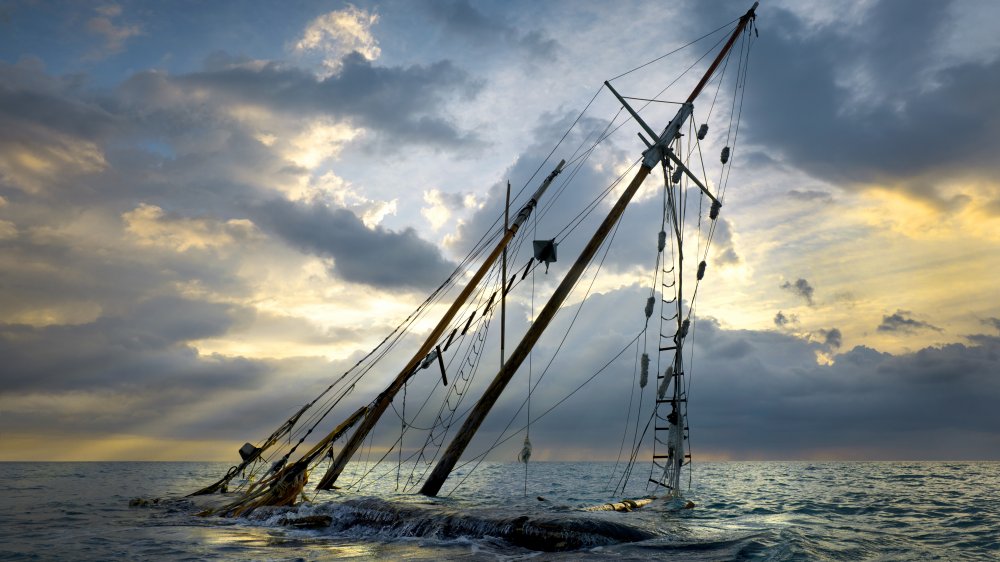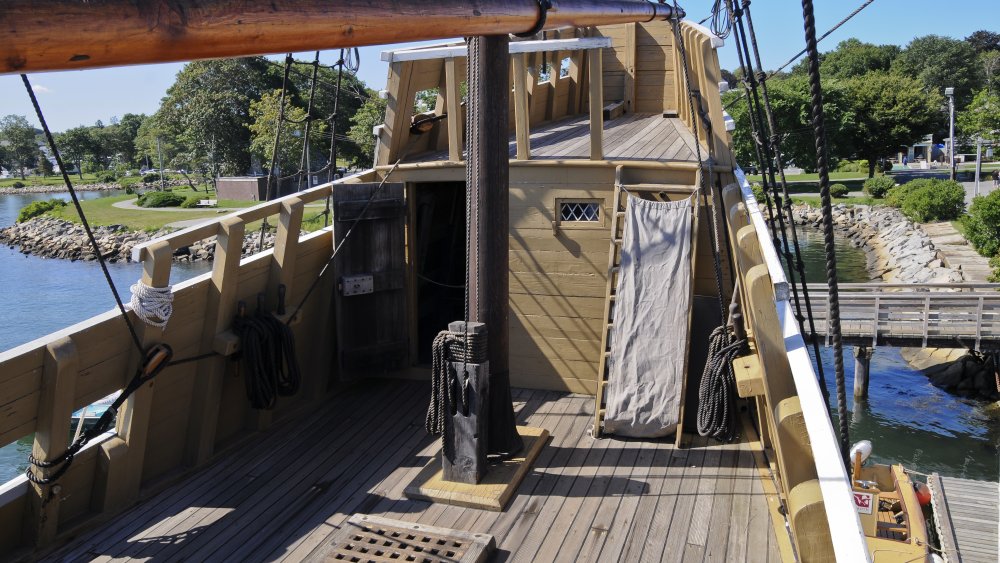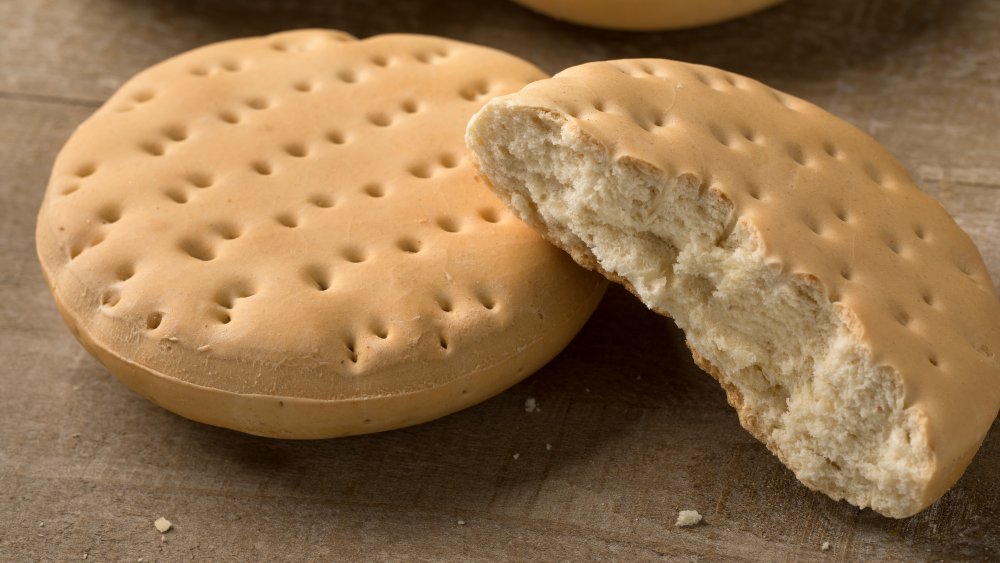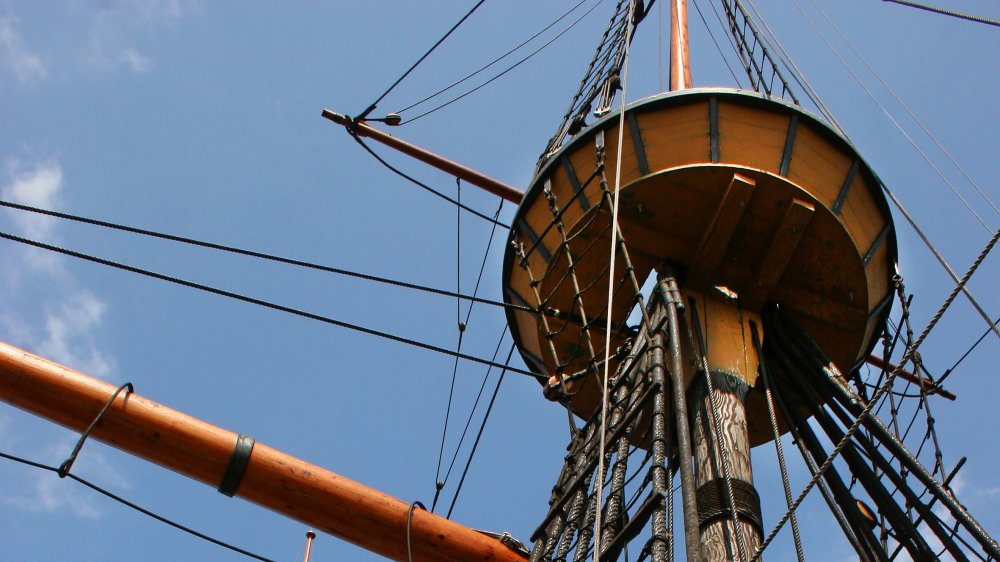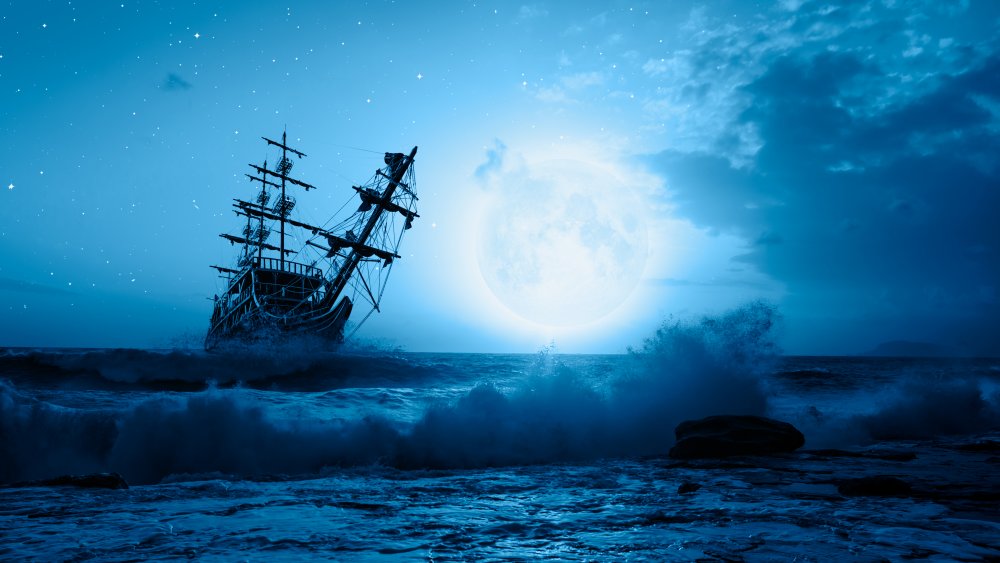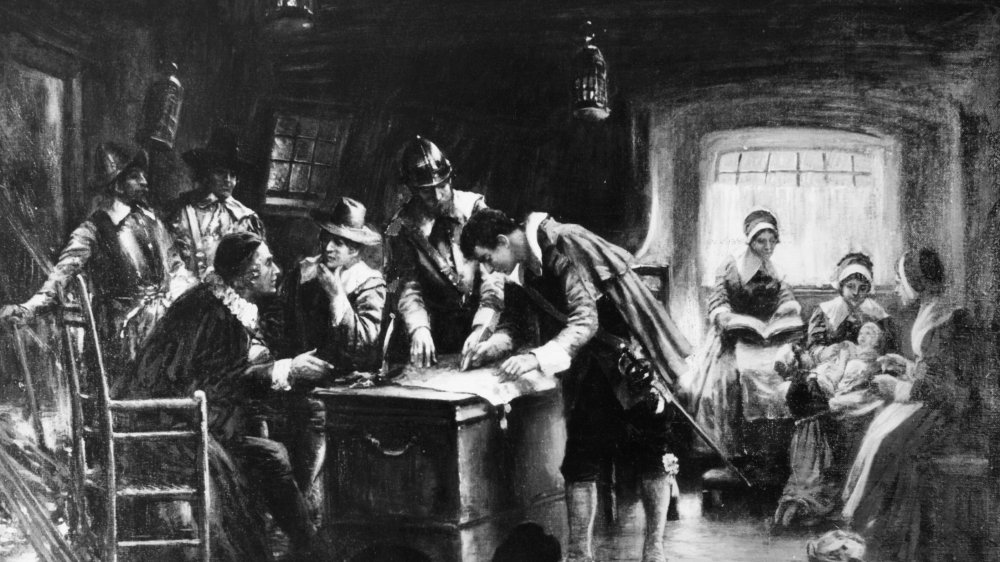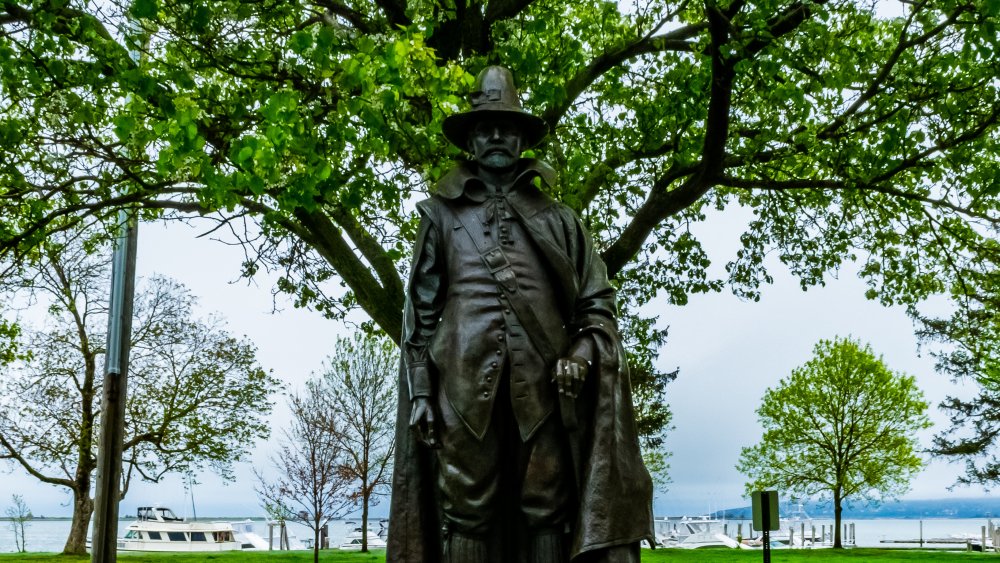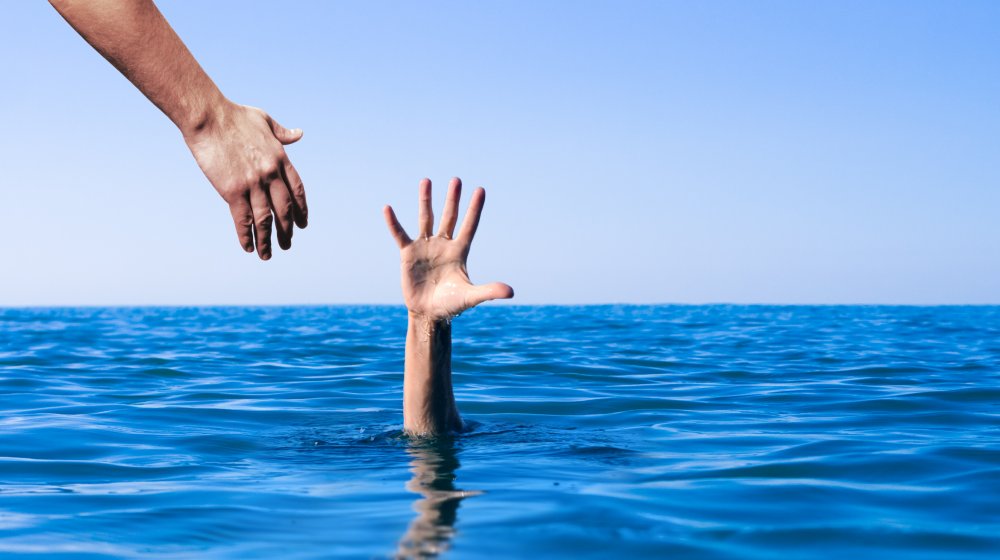What It Was Really Like Sailing On The Mayflower
For a ship associated with one of the most important events in American history, we don't know much about the Mayflower. We're not certain precisely what the ship looked like, but based on port records and other ships of the period, we can make a pretty good guess. It was a merchant ship, not a passenger ship, and was probably designed to hold casks of wine instead of people. Due to laws in effect at the time that required all ships to potentially serve in a war, it probably had raised "castles" at either end, which would help defend it against boarding. That design also probably made it very difficult to handle in high winds.
Beyond that, we can only guess. While the ship that brought the Pilgrims to America is an iconic part of our colonial history and taught to every school kid in the country, the actual voyage is often glossed over. But it took real effort and dedication to make the 66-day journey from England to Plymouth, Massachusetts — so much effort that when everyone realized they were several hundred miles away from their actual destination in Virginia, they decided it was easier to stay where they were than try again. Here's what it was really like sailing on the Mayflower.
The Mayflower passengers kept a low profile
One reason we have so little information about the Mayflower stems from the secretive way the Pilgrims behaved. As noted by Smithsonian Magazine, the Pilgrims were a group of folks who took the protestant revolution very, very seriously. They thought the Church of England hadn't done enough to shed the decadent, ritual-soaked culture of the Catholic Church, and so they decided to leave the church.
This was controversial. And since the King of England was also the head of the Church of England, kind of treasonous. They suffered persecution as a result and faced the possibility of prison. So they fled to Holland, where they enjoyed religious freedom but found the culture shock too much. That led a small group of them to the crazy idea of sailing to the New World, where they hoped they could live as they wished.
But that meant sneaking back into England. And every moment they spent in England left them open to the possibility of arrest or other negative consequences. As The Conversation notes, they kept a low profile as they made their arrangements. This is one reason we know so little about the ship itself: The preparations for the voyage were done very secretly in order to stay under the radar. The name of the ship, the Mayflower, only became known three years after the historic voyage.
The Mayflower was incredibly crowded
As noted by The Conversation, the Pilgrims originally had two ships hired for the transatlantic voyage to America: The Mayflower and the Speedwell.
What, you didn't learn about the Speedwell in school? Probably because it was pretty bad at doing the one thing ships are supposed to do: Stay afloat. After bringing the Pilgrims to England from Holland in July 1620, some of the group boarded the 180-ton Mayflower while the rest stayed on the 60-ton Speedwell, and the two ships set off for America. And almost immediately had to turn back because the Speedwell was leaking so badly. According to Scholastic, eventually, they had to abandon the smaller ship and transfer those who were willing to continue their journey onto the Mayflower.
The larger ship was originally a merchant ship designed to haul wine and other cargo — not a passenger ship. The 102 passengers were crowded below deck in very, very small areas that were used for everything, including sleep. The ceilings were very low, there was no light or fresh air, and most of the time, the passengers had to stay below decks to avoid getting in the crew's way. There were roughly 30 crew members as well, adding to the crowding. Now imagine living like this for more than two months.
The accommodations on the Mayflower were awful
Not only was the Mayflower crowded, but it also wasn't exactly a four-star hotel. Or a one-star hotel. In fact, the accommodations would probably be classified as terrible even in the early 17th century.
As noted by Scholastic, there were no such things as a private cabin on the Mayflower. Everyone was crowded into a large space between decks that had originally been used for cargo. There was zero privacy, so the Pilgrims and other passengers hung sheets and blankets or put up crude wooden barriers around their allotted floor space in order to get some semblance of privacy. Everyone had to wash, eat, and do everything else — and we mean everything else — right there, surrounded by their fellow passengers.
Worse, keeping clean would have been a challenge. Aside from having to bathe with almost no privacy, fresh water was in limited supply. As long as there was fresh water, people would have tried to wash up as much as possible, but no one would have been considered "clean" by modern standards. Worst of all, as author Nathaniel Philbrick points out, would have been the "omnipresent" chamber pots where everyone went to the bathroom. If you think using what was essentially a bucket for this purpose is bad, consider that it wouldn't be possible to empty the chamber pots when the weather was bad. Unfortunately, there was a lot of bad weather during their journey.
Navigation was difficult in 1620
The Pilgrims famously arrived very far away from their original destination. In reality, being a few hundred miles off course was well within the acceptable margin of error at the time. Simply put, sailing across the Atlantic Ocean in the 17th century was no easy task. The Pilgrims spent a great deal of their journey uncertain of their precise location, direction, or speed.
As The Conversation explains, the sailors on board the Mayflower used a magnetic compass to find North, and a knotted rope to determine their speed (by dropping one end into the water and timing how quickly the knots went by — that's where we get the nautical term knots). They would measure the height of the North Star to determine their latitude and use a technique known as "dead reckoning" to figure out their longitude. Unfortunately, the dead reckoning became increasingly inaccurate the further away from shore you went. There was a way to calculate longitude by measuring the sun and noting the time, but as The Verge notes, a clock accurate enough to be used on sea voyages wasn't invented until the 18th century.
When they arrived in North America and realized how far off course they were, there was an attempt to sail south, but the currents didn't cooperate. So they decided to stay. After not knowing exactly where they were for 66 days, it might have seemed appropriate to not know exactly where they'd landed.
The Mayflower voyage took far longer than expected
The voyage from England to America took the Pilgrims and the other passengers 66 days — significantly longer than the usual 30 days. And that was after the trip was delayed before they even left England.
According to History.com, the passengers originally left for America on two ships, the Speedwell and the Mayflower, in August of 1620. The Speedwell began to leak. According to author Nathaniel Philbrick, this was because the ship had been purposefully "overmasted," probably in order to take the passengers' money, then weasel out of actually making the voyage. Regardless of the reason, everyone had to turn around and head back to England and then crowd onto the Mayflower.
When they finally got underway for real, the delays meant they were sailing during the stormy season. As HistoryExtra points out, the likely design of the Mayflower with its high sides and castle-like structures on each end made it very difficult to sail in rough weather. Author Nathaniel Philbrick notes that when things got really bad, Captain Christopher Jones very likely had to "lie ahull," meaning the sails were furled and the ship turned to shelter from the wind. This maneuver would have kept the ship from swaying dangerously in the wind, but also stopped forward progress until the weather improved.
The Mayflower stank
As a sophisticated modern person, you probably think you have smelled some terrible things in your time. But you have likely never smelled anything as bad as the Mayflower.
As Scholastic points out, the ship was very crowded with people, most of whom had never been on the open sea before. That means most of them were very seasick most of the time — and unable to go up onto the main deck. As a result, they had to get sick right there, into their chamber pots if possible. And those chamber pots couldn't be emptied in bad weather, contributing to the stink. Worse, you couldn't take a bath. While people tried to stay clean, 102 people taking zero baths for 66 days is an equation with a solution that smells really, really bad.
In addition to the people, there were animals on board as well, which contributed to the smell. Author Nathaniel Philbrick confirms there were at least two dogs on board the ship, and authors Peter Arenstam, John Kemp, and Catherine O'Neill Grace note there were animal pens on board, most probably for chickens and possibly some pigs or goats. If you've ever been near a farm, you can imagine just what these animals contributed to the air quality on board.
Everyone was hungry and thirsty on the Mayflower
Since there was no Uber Eats back in 1620, all the passengers on the Mayflower brought along food supplies for the voyage. While there was probably fresh food and water in the beginning, it was consumed right away since it wouldn't last very long. What was left was probably salted meat, a biscuit called hardtack, and beer. In fact, as HowStuffWorks reports, low alcohol beer was an essential staple of everyone's diet, because the water was scarce or dangerous to drink. It's speculated that the crew of the Mayflower forced the Pilgrims to leave the ship at Plymouth in order to conserve the remaining beer supply.
As author Nathaniel Philbrick notes, however, the passengers brought provisions for a journey that was expected to take about a month. As the delays piled up due to bad weather, food and water began to run low. Compounding the problem was a lack of firewood and the fact that they couldn't build fires during the really inclement weather, which meant there was very little hot food. The passengers began to suffer from various mystery illnesses related to malnutrition, most notably scurvy, marked by loose teeth and bleeding gums.
Miraculously, just one of the passengers, William Burton, died on the voyage despite these challenges. Although as Scholastic notes, the Pilgrims' lack of nutrition on board no doubt contributed to their terrible first winter in the New World, when many of the Pilgrims did, in fact, die of malnutrition.
It was incredibly noisy on the Mayflower
Sleeping on a sailing ship in the early 17th century wasn't easy in general, but the people on the Mayflower had to deal with two main obstacles to a good night's rest. One was being cooped up below decks all the time, which made it difficult to keep track of days. The other was the noise.
As this article posted by the Royal Museums Greenwich explains, a sailing ship was a 24-hour operation. The crew was divided into "watches" who would take turns ensuring that the ship didn't flounder or go off course. That means there was never a time when the crew wasn't making a lot of noise, shouting, and adjusting the sails. And as historian Berenson Little notes, this often resulted in sleep deprivation being a real problem for the sailors, so it's very likely it was nearly impossible for the passengers to get a solid night's sleep even in good weather.
As Scholastic notes, a sailing ship on the ocean is also just naturally noisy. Creaking rope and beams, snapping sails, howling wind, and slapping waves are just some of the natural noises that the crew and passengers would have to block out in order to get some rest or peace of mind.
The Mayflower almost had to turn back after storm damage
Sailing the open sea in the days before radio was a perilous proposition. If your ship suffered damage, you had to make repairs using what you had.
The Mayflower was not a ship that did well in bad weather, and all it saw on the 66-day journey to America was bad weather. As the authors of Mayflower 1620 point out, about halfway through the journey, a severe storm left one of the main support beams cracked. Considering the ship was literally in the middle of the ocean, far away from any sort of assistance, this was pretty worrying to the crew. There was a serious discussion about turning back and heading for home. Some of the crew feared the ship might break apart in the next bad storm.
But as author Nathaniel Philbrick recounts, the passengers were not going to let all their effort go to waste. The Mayflower crew had brought with them a "screw jack" (similar to modern screw jacks that are still used today) that they intended to use in building houses for themselves. It was capable of lifting heavy objects, so they broke it out and used it to lift the beam back into place. This allowed the ship's carpenter to brace the beam. Reinforced, the Mayflower was able to continue the journey.
It was incredibly boring on the Mayflower
The Mayflower was not a cruise ship. The trip across the Atlantic Ocean was incredibly dangerous, and the ship was a cargo ship that had (barely) been converted into a passenger ship. Not only were the 102 passengers crowded into a tiny space with little or no privacy, but they also had very little to do. The passengers couldn't help with any of the work involved in sailing the ship, and often got in the way if they wandered out of their designated area.
As The Christian Science Monitor notes, things quickly got really, really boring. As a result, the passengers had to find ways to entertain themselves, which typically involved asking each other riddles, telling stories, and playing simple games like Nine Men's Morris (a strategy board game). Like people throughout history, they probably told each other every story they knew.
As Scholastic points out, one aspect of this boredom is often overlooked: The food. The menu would have been limited to begin with, but as the voyage dragged on and food stores ran low, the meals would have become incredibly repetitive. Imagine eating the same salted beef and a hard biscuit every day, several times a day, and you can easily imagine how boring the food became. Of course, as CS Monitor helpfully reminds us, most of the passengers were probably too terrified to be bored much of the time.
Everyone on the Mayflower hated each other
Many people assume that the Mayflower's passengers were all what we refer to today as the Pilgrims — religious fanatics seeking a new world where they could worship in peace. But as History.com points out, of the 102 passengers just 41 were Pilgrims. Yhey referred to themselves as "Saints" because what's the point about being a religious fanatic if you can't be smug about it?
They referred to the other passengers as "Strangers," and there was little love lost between the two groups. As The Daily Beast notes, the "Strangers" were mostly people fleeing jail or debts — not exactly upstanding citizens. Per Reason.com, the difference in worldview guaranteed that the two groups would be at odds.
Of course, there was a third group on board the Mayflower who hated both of them: The crew. As author Nathaniel Philbrick writes, when the passengers began to suffer from seasickness, the crew "took great delight" in mocking their suffering. One sailor in particular liked to tell them that he looked forward to throwing their bodies over the side when they died. The rancor was so bad that when that sailor took sick himself and died during the voyage, the leader of the Saints, William Bradford (above), called him a "profane young man" and called his death the "just hand of God upon him." So much for being a saint.
One man went overboard on the Mayflower — but saved himself
Among the passengers on the Mayflower were a few indentured servants. These were people who had agreed to work for no pay until a debt was satisfied. One of these was John Howland.
After about a month at sea, the Mayflower was beset by a terrible storm. The captain maneuvered the ship so that the howling winds didn't rock her too badly, producing an almost peaceful calm for those inside the ship. As Nathaniel Philbrick writes, Howland was suffering a bit of cabin fever in the dark, hot, bad-smelling cargo area. With the ship so calm, he thought he could risk going on deck for some fresh air. But lacking any sort of experience with sailing ships, he had no idea how violent the storm would be — or how deceptive the interior calm of the ship was.
Howland was promptly swept overboard, and by all rights should have died. But he somehow caught hold of a rope trailing the Mayflower and hung on even as he was plunged 10 feet below the water. The crew miraculously spotted Howland and hauled him back in, using a boat hook to pull him back to safety. As Philbrick notes, Howland went on to father 10 children who then had a remarkable 88 grandchildren between them. The New World would have been very different if he had died at sea.
